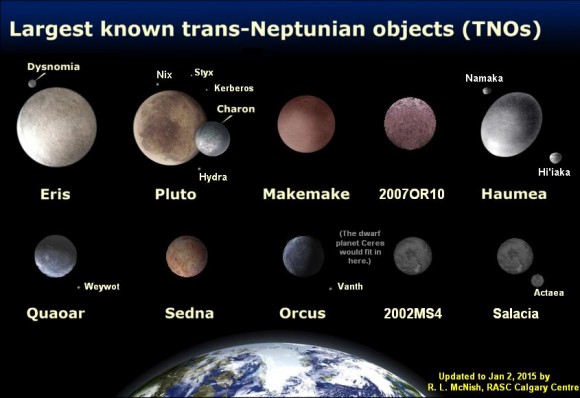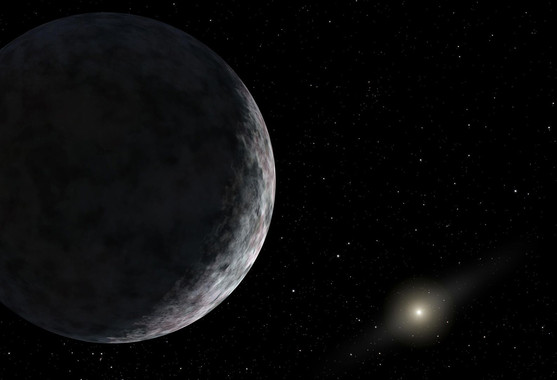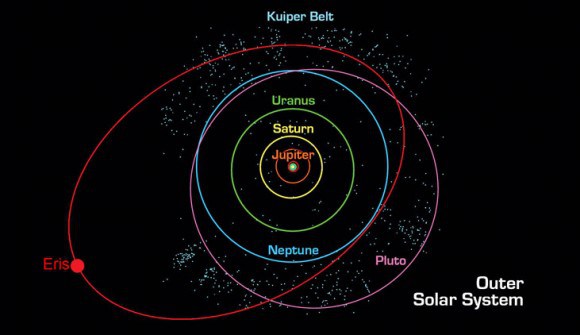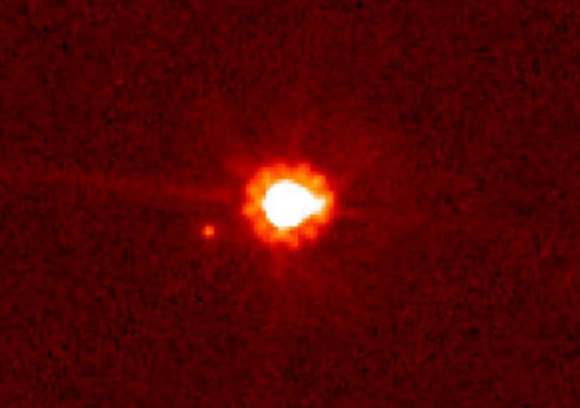


Artist's concept of the hypothetical "Planet Nine". Credit: NASA/JPL-Caltech/Robert Hurt
ON THE DETECTABILITY OF PLANET X WITH LSST (PDF)
Main Page of the LSST

Artist’s impression of the Large Synoptic Survey Telescope (LSST). Credit: lsst.org

Animated diagram showing the spacing of the Solar Systems planet’s, the unusually closely spaced orbits of six of the most distant KBOs, and the possible “Planet 9” (aka. “Planet X”). Credit: Caltech/nagualdesign

The orbits of several KBOs provide indications about the possible existence of Planet 9. Credit: Caltech/R. Hurt (IPAC)

The presently known largest small bodies in the Kuiper Belt are likely not to be surpassed by any future discoveries.
This is the conclusion of Dr. Michael Brown, et al. (Illustration Credit: Larry McNish, Data: M.Brown)
The self-professed �Pluto Killer� is at it again. Dr. Michael Brown is now reminiscing about the good old days when
one could scour through sky survey data and discover big bright objects in the Kuiper Belt. In his latest research paper,
Brown and his team have concluded that those days are over.



At least two unknown planets could exist in our solar system beyond Pluto. / Credit: NASA/JPL-Caltech.
Could there be another Pluto-like object out in the far reaches of the Solar System? How about two or more?
Earlier this week, we discussed a recent paper from planet-hunter Mike Brown, who said that while there aren�t likely to be any bright,
easy-to-find objects, there could be dark ones �lurking far away.� Now, a group of astronomers from the UK and Spain maintain at
least two planets must exist beyond Neptune and Pluto in order to explain the orbital behavior of objects that are even farther out,
called extreme trans-Neptunian objects (ETNO).


Artist illustration of the dwarf planet Eris. Image credit: NASA

Artist’s impression shows the distant dwarf planet Eris, highlighting its bright surface. Credit: ESO

A diagram showing solar system orbits. The highly tilted orbit of Eris is in red. Credit: NASA

Eris (center) and its moon of Dysnomia (left of center), taken by the Hubble Space Telescope. Credit: NASA/ESA/Mike Brown
Eris (center) and its moon of Dysnomia (left of center), taken by the Hubble Space Telescope. Credit: NASA/ESA/Mike Brown

Artist Impression of ERIS and it's moon Dysmonia

An artist’s conception of Sedna. This depiction assumes that Sedna has a tiny as yet undiscovered moon. Image credit; NASA/JPl-Caltech

A capture of Haumea… with an 8″ telescope! The brilliant star in the frame is magnitude +2.7 Eta Boötis
(Murphid). Image credit: Mike Weasner/Cassiopeia observatory

Artist’s impression of the dwarf planet Haumea and its moons, Hi’aka and Namaka. Credit: NASA

An artists’ conception of the strange environs of Haumea and friends. Image credit: Harvard-Smithsonian CfA

The orbit of 136108 Haumea. Image credit: NASA/JPL

Haumea and friends: orbital inclinations of TNO/KBO families vs AU distance. Image credit: Wikimedia/Eurocommuter
Published on Mar 3, 2015 Three kerbals touch down on the surface of the small moon Hi'iaka in the depths of the Kuiper Belt.
Hi'iaka, along with Namaka, orbits the large dwarf planet Haumea, with its dramatic ellipsoid shape
(see video icon to appreciate this, as KSP cannot render it for larger objects).
After a relatively painless docking high above Hi'iaka's plains, the kerbals prepare to embark on the next leg of their journey: Orcus and Vanth.
Suggest future objects for visiting in the comments. Avoid tiny objects please, and dwarf planets with moons are a big plus.
Suggestions here:... (Orcus and Vanth are next) RIP NOBODY! This time... SRB Gaming Category Gaming License Standard YouTube License
(Click on the youtube icon and it will run) Uploaded on Sep 11, 2009 My rendition of the dark red spot on the surface of Kuiper belt object Haumea. Music "ピエール" by Playdoh ( • • )

Artist concept of Haumea, with the correct proportions of the main body and the ring. The ring is at a distance of 2287 kilometers from the center of the main body and is darker than the surface of the dwarf planet itself. Credit: Instituto de Astrofísica de Andalucía.
Outreach video produced on the occasion of the publication (in Oct. 2017) in Nature of the paper entitled "The size, shape, density and ring of the dwarf planet Haumea from a stellar occultation" by J.L. Ortiz et al.

Artist’s impression of the dwarf planet Haumea and its moons, Hi’aka and Namaka. Credit: NASA

Artist’s impression of the Kuiper Belt Object and possible dwarf planet Quaoar. Credit: reborbit.com

Images of Quaoar taken using the Oschin Telescope at the Palomar Observatory, California. Credit: Chad Trujillo & Michael Brown (Caltech)

The orbit of Quaoar (yellow) and various other cubewanos compared to the orbit of Neptune (blue) and Pluto (pink). Credit: Wikipedia Commons/kheider

Artist’s impression of the moderately red Quaoar and its moon Weywort.

Artist’s impression of the Trans-Neptunian Object (TNO) 90482 Orcus. Credit: NASA

90482 Orcus. The location of Orcus is shown in the green circle (top, left). Credit: NASA

An artist’s conception of 2007 OR10, nicknamed Snow White. Astronomers suspect that its rosy color
is due to the presence of irradiated methane. Credit: NASA

Artistic rendering shows the distant view from theoretical Planet Nine back towards the sun.
The planet is thought to be gaseous, similar to Uranus and Neptune.
Hypothetical lightning lights up the night side.
Credit: Caltech/R. Hurt (IPAC)


The six most distant known objects in the solar system with orbits exclusively beyond Neptune (magenta)
all mysteriously line up in a single direction. Also, when viewed in three dimensions,
they tilt nearly identically away from the plane of the solar system. Batygin and Brown show that a planet
with 10 times the mass of the earth in a distant eccentric orbit anti-aligned with the other six objects (orange)
is required to maintain this configuration.
Credit: Caltech/R. Hurt (IPAC); [Diagram created using WorldWide Telescope.]

Based on a careful study of Saturn’s orbit and using mathematical models,
French scientists were able to whittle down the search region for Planet Nine to “possible” and “probable” zones.
Source: CNRS, Cote d’Azur and Paris observatories , created by the author
(click on the gray out icon video will start) Published on Jan 20, 2016 NASA’s Director of Planetary Science, Jim Green, discusses the Jan. 20 Astronomical Journal science paper
that points to the possibility of a new “Planet 9” in our solar system beyond Pluto,
examining the scientific process and inviting you to have a front row seat to our exploration of the solar system. Category Science & Technology License Standard YouTube License

A predicted consequence of Planet Nine is that a second set of confined objects should also exist.
These objects are forced into positions at right angles to Planet Nine and into orbits that are perpendicular to the plane of the solar system.
Five known objects (blue) fit this prediction precisely.
Credit: Caltech/R. Hurt (IPAC) [Diagram was created using WorldWide Telescope.]



BACKYARDWORLDS.org Searching for planet 9





Artist's concept of the hypothetical "Planet Nine". Credit: NASA/JPL-Caltech/Robert Hurt





Astronomers have found a new dwarf planet way out beyond Pluto that never gets closer than 65 AUs to the Sun. It’s nicknamed “The Goblin” which is much more interesting than its science name, 2015 TG387. The Goblin’s orbit is consistent with the much-talked-about but yet-to-be-proven Planet 9.

Dwarf planet 2015 TG387, or Goblin, has an orbit that takes it much further from the Sun than other Inner Oort Cloud Objects Sedna and 2012 VP113. Image: Roberto Molar Candanosa and Scott Sheppard, courtesy of Carnegie Institution for Science.

A figure from the study shows the orbit of 2015 TG387 and other distant objects in the Solar System. According to the paper, ” 2015 TG387 continues the longitude clustering trend seen for the inner Oort cloud objects and ETNOs, which might be caused by a massive planet (Planet 9) shepherding these objects.” Image: Shepard et. al., 2018
Fraser Cain Published on Sep 17, 2013 In this short video explainer, Universe Today publisher investigates the myth of Planet X. No, there isn't a big planet coming our way. But the myth and allure of more planets out there has kept astronomers busy for centuries. And could there be a huge planet, still undiscovered, out beyond the orbit of Pluto?
Have you heard there's a giant planet in the Solar System headed straight towards Earth? At some point in the next few months or years, this thing is going to crash into Earth or flip our poles, or push us out of our orbit, or some other horrible civilization destroying disaster. Are these rumours true? Is there a Planet X on a collision course with Earth? Unlike some of the answers science gives us, where we need to give a vague and nuanced answers, like yes AND no, or Maybe, well, it depends... I'm glad to give a straight answer: "No". Any large object moving towards the inner Solar System would be one of the brightest objects in the night sky. It would mess up the orbits of the other planets and asteroids that astronomers carefully observe every night. There are millions of amateur astronomers taking high quality images of the night sky. If something was out there, they'd see it. These rumours have been popping up on the internet for more than a decade now, and I'm sure we'll still be debunking them decades from now. What people are calling Planet X, or Nibiru, or Wormwood, or whatever doesn't exist. But is it possible that there are large, undiscovered objects out in the furthest reaches of Solar System? Sure. Astronomers have been searching for Planet X for more than a hundred years. In the 1840s, the French mathematician Urbain Le Verrier calculated that another large planet must be perturbing the orbit of Uranus. He predicted the location where this planet would be, and then German astronomer Johann Gottfried Galle used those coordinates to discover Neptune right where Le Verrier predicted. The famed astronomer Percival Lowell died searching for the next planet in the Solar System, but he made a few calculations about where it might be found. And in 1930, Clyde William Tombaugh successfully discovered Pluto in one of the locations predicted by Lowell. Astronomers continued searching for additional large objects, but it wasn't until 2005 that another object the size of Pluto was finally discovered by Mike Brown and his team from Caltech: Eris. Brown and his team also turned up several other large icy objects in the Kuiper Belt; many of which have been designated dwarf planets. We haven't discovered any other large objects yet, but there might be clues that they're out there. In 2012, the Brazilian astronomer Rodney Gomes calculated the orbits of objects in the Kuiper Belt and found irregularities in the orbits of 6 objects. This suggests that a larger object is further out, tugging at their orbits. It could be a Mars-sized object 8.5 billion km away, or a Neptune-sized object 225 billion km away. There's another region at the edge of the Solar System called the Oort Cloud. This is the source of the long-period comets that occasionally visit the inner Solar System. It's possible that large planets are perturbing the orbits of comets with their gravity, nudging these comets in our direction. So, feel free to ignore every single scary video and website that says an encounter with Planet X is coming. And use that time you saved from worrying, and use it to appreciate the amazing discoveries being made in space and astronomy every day.
<>
An exploration into a new paper by Dr. Konstanin Batygin and Mike Brown that goes over the Injection of Inner Oort Cloud Objects Into the Distant Kuiper Belt by Planet Nine. Planet Nine is an as yet undiscovered planet that may lurk in the outer solar system. Injection of Inner Oort Cloud Objects Into the Distant Kuiper Belt by Planet Nine by Konstantin Batygin and Michael E. Brown (PDF) Eduardo Marturet - Planet 9, Op. 3 Konstantin’s Band Patreon: Want to support the channel? Follow us at other places! Website: Twitter: Instagram: Music featured on Event Horizon Stellar Drone Miguel Johnson Bandcamp Leerosevere Bandcamp Aeriumambient Bandcmp FOOTAGE: NASA ESA/Hubble ESO - M.Kornmesser ESO - L.Calcada ESO - Jose Francisco Salgado (josefrancisco.org"> NAOJ University of Warwick Goddard Visualization Studio Langley Research Center Pixabay